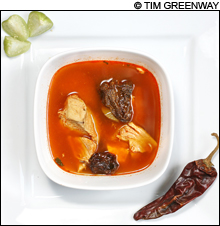
STRIKING COLORS Caldo tlalpeño is brightly delicious. |
Well into her 30s with two kids and a husband, Azminda was still being ribbed by her father for being a bad cook. "You need to learn," he said in Mexican Spanish, "You won't always have your mother and your sister to do it for you!" Last year, his warning came true. The company Azminda's husband worked for, Unum in Mexico City, asked him to transfer to its office in Maine. Because the kidnapping of children for ransom had become so frequent where she lived and the police force so corrupt, the family decided to go. Azminda left the fresh roses growing in the garden all year long, her job as an economist, her mother's and sister's amazing cooking, and her beloved (and affordable!) house helper Conchita, and got her family settled in an apartment in Yarmouth. Then she set out to learn English and run the family household. Her mother sent key recipes.Just a year later, Azminda couldn't believe she, the black sheep of the family cooks, was about to give a newspaper reporter a cooking lesson — in English! But I insisted. Four years into my quest to learn and pass on a favorite dish from every country in the world, Mexico, our southern neighbor, had eluded me. Her nervousness, however, did raise a suspicion: perhaps my stroke of uncanny luck was coming to an end. After walking into the kitchens of more than 50 people from foreign countries, whom I mostly met circumstantially in check-out lines of non-culinary places like office-supply stores, I was bound to come upon a dish that was not worthy of broadcasting to the world.
But then she said, "But you don't have to be a good cook to make this. That's what my mom said. It's easy." Even though I suspect a "non-cook" in Mexico still makes better food than a non-cook in the United States, I was relieved. An easy dish from Mexico? That's blockbuster material!
The recipe she taught me was caldo tlalpeño, her husband's favorite, served typically in Mexico for the main meal of the day, around 2 or 3 pm. This soup is ingenious. It's basically a chicken soup with chunks of chicken meat and potato, but the broth is this amazingly appetizing translucent red color, and there are various floating chili peppers on top. First you cook skinless chicken pieces covered in salted water. Then you soak mild but colorful guajillo chili peppers in water to soften them. "The package says 'guajillo' here," Azminda instructs, "but it's spelled 'uhajillo' back home." You blend the chilis in a blender with a little water, which turns brilliant red. Then you pour the chili-water through a strainer into the chicken broth, which turns the soup broth its lovely color and flavor. Then you mix in chicken bouillon. "In Mexico," she says, "We use chicken bouillon a lot — for every food." Finally, you add a couple rinsed whole dried habanero and chipotle peppers, which look really gnarly and cool and ensure a dynamic spice level for eaters.
Soon a whole chili-pepper aisle unfolded on her dining room table, thousands of dried chilis of about a dozen different varieties. I'm thinking either my theory is right about non-cooks from Mexico or Azminda became a great cook in a year. "Ancho makes color and a little taste. Arbol — only for heat. Pulla is great color, medium spicy, picoso. Japones, hotter."
Get the recipe, sign up for the next cooking class ("A Spicy-Food Lover's Dream"), or contact the author at ImmigrantKitchens.com.